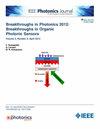傅里叶平面显微镜的物理信息解耦校准
IF 2.4
4区 工程技术
Q3 ENGINEERING, ELECTRICAL & ELECTRONIC
引用次数: 0
摘要
傅里叶显微成像(FPM)是一种很有前途的大视场和高分辨率的定量相位成像技术,但它需要精确的照明角度来进行精确的重建。传统算法难以快速分离系统错误,并对成像系统施加了严格的约束。为了解决这个问题,我们提出了一个物理解耦校正框架,该框架集成了卷积神经网络(CNN)、模拟退火(SA)算法和GPU并行加速。CNN提取与LED定位误差相关的频域圆形特征作为物理先验,gpu加速的SA算法精确求解FPM前向传播过程中LED阵列的空间参数。由于该方法与相位恢复解耦,单轮校准参数适用于多种条件,将误差校正时间缩短了67.7%,将成像效率提高了60.1%。实验验证了其精确校准LED位置的能力,增强了FPM的鲁棒性,为高效的全场误差校正奠定了坚实的算法基础。本文章由计算机程序翻译,如有差异,请以英文原文为准。
Physics-Informed Decoupled Calibration for Fourier Ptychographic Microscopy
Fourier ptychographic microscopy (FPM) is a promising quantitative phase imaging technique with large fields of view and high resolution, but it requires precise illumination angles for accurate reconstruction. Conventional algorithms struggle to rapidly separate system errors and impose strict constraints on imaging systems. To address this, we propose a physically decoupled correction framework integrating convolutional neural network (CNN), simulated annealing (SA) algorithms, and GPU parallel acceleration. The CNN extracts frequency-domain circular features related to LED positioning errors as physical priors, while the GPU-accelerated SA algorithm accurately solves LED array spatial parameters during FPM forward propagation. Because this method is decoupled from phase recovery, single-round calibration parameters apply to diverse conditions, reducing error correction time by >67.7% and improving imaging efficiency by >60.1%. Experiments verify its ability to precisely calibrate LED positions, enhancing FPM robustness and laying a solid algorithmic foundation for efficient full-field error correction.
求助全文
通过发布文献求助,成功后即可免费获取论文全文。
去求助
来源期刊

IEEE Photonics Journal
ENGINEERING, ELECTRICAL & ELECTRONIC-OPTICS
CiteScore
4.50
自引率
8.30%
发文量
489
审稿时长
1.4 months
期刊介绍:
Breakthroughs in the generation of light and in its control and utilization have given rise to the field of Photonics, a rapidly expanding area of science and technology with major technological and economic impact. Photonics integrates quantum electronics and optics to accelerate progress in the generation of novel photon sources and in their utilization in emerging applications at the micro and nano scales spanning from the far-infrared/THz to the x-ray region of the electromagnetic spectrum. IEEE Photonics Journal is an online-only journal dedicated to the rapid disclosure of top-quality peer-reviewed research at the forefront of all areas of photonics. Contributions addressing issues ranging from fundamental understanding to emerging technologies and applications are within the scope of the Journal. The Journal includes topics in: Photon sources from far infrared to X-rays, Photonics materials and engineered photonic structures, Integrated optics and optoelectronic, Ultrafast, attosecond, high field and short wavelength photonics, Biophotonics, including DNA photonics, Nanophotonics, Magnetophotonics, Fundamentals of light propagation and interaction; nonlinear effects, Optical data storage, Fiber optics and optical communications devices, systems, and technologies, Micro Opto Electro Mechanical Systems (MOEMS), Microwave photonics, Optical Sensors.
 求助内容:
求助内容: 应助结果提醒方式:
应助结果提醒方式:


